The Women Before
By Surya Milner ’19As we mark fifty years of coeducation at Bowdoin, it is easy to think of a stark line between the days of women at the College and the days before, when there were none. But of course there were women at and around Bowdoin. They not only had a presence and an influence—they were in many ways where the thread began.
In 1904, Kate Douglas Wiggin received the second honorary degree granted by the College to a woman (the first was Sarah Orne Jewett in 1900).
As twenty-nine-year-old German professor Helen Cafferty walked across the Quad, her suede flats left colorful imprints in the wet February snow. She didn’t think much about it at the time: she had just flown in from Detroit and was wrapping up a series of interviews for a faculty position at the College. But months later, after she’d begun teaching classes in the basement of Memorial Hall, she realized some symbolism in those hyper-visible footprints. She was a woman at Bowdoin, the first female professor hired to teach there, and, as she remembers, “Bowdoin was a gentlemanly place.”
Bowdoin had only recently opened its doors to women as students at the beginning of that academic year. In that first year, women comprised just 14 percent of the student body. Cafferty was one of three women faculty hired in 1972. Despite the striking image of her footprints, and the symbol she took them to be at the time, she knew she was far from the first woman to shape the College’s landscape. “There had always been an important female presence at Bowdoin,” she remembers, referring to the wives of the male faculty, who until that point represented the largest group of women on campus. “These women were highly educated in their own right.”
In the two centuries prior, when Bowdoin was a growing college on a gentle, sloping hill, women orbited the College in many ways. They were writers, mothers, botanists, academics, secretaries, wives. They created spheres—big and small, physical and felt—of art, literature, and community.
For the Bowdoin student of today, the story of the College takes shape through a specific mélange of personal and institutional mythology. Each newly formed class arrives on campus with ideas, both vague and distinct, about the people who came before them. Scrawling one’s signature in the leather-bound matriculation book in the president’s office connects each incoming student with Bowdoin’s lineage. But the story of Bowdoin is shaped by many more names than are often given credit. What follows is a sketch of some of those people. In the classroom, in the community, at events both formal and informal, women made deep inroads at the College, paving a path to coeducation.
One hundred years before Cafferty arrived on campus, Bowdoin had just welcomed its sixth president, a renowned alumnus and Civil War hero with a horseshoe mustache who believed that women belonged at Bowdoin. At his inaugural address in 1871, Joshua Lawrence Chamberlain, of the Class of 1852, lamented an “old Bowdoin,” a place where women were “banished and hence degraded, so that even to admit her to a place in the higher education is thought to degrade a college.” In the next iteration of Bowdoin, he said, “women too should have a part in this high calling [education] because in this sphere of things her ‘rights,’ her capabilities, her offices, her destiny are equal to those of man. She is the Heaven-appointed teacher of man, his guide, his better soul.”
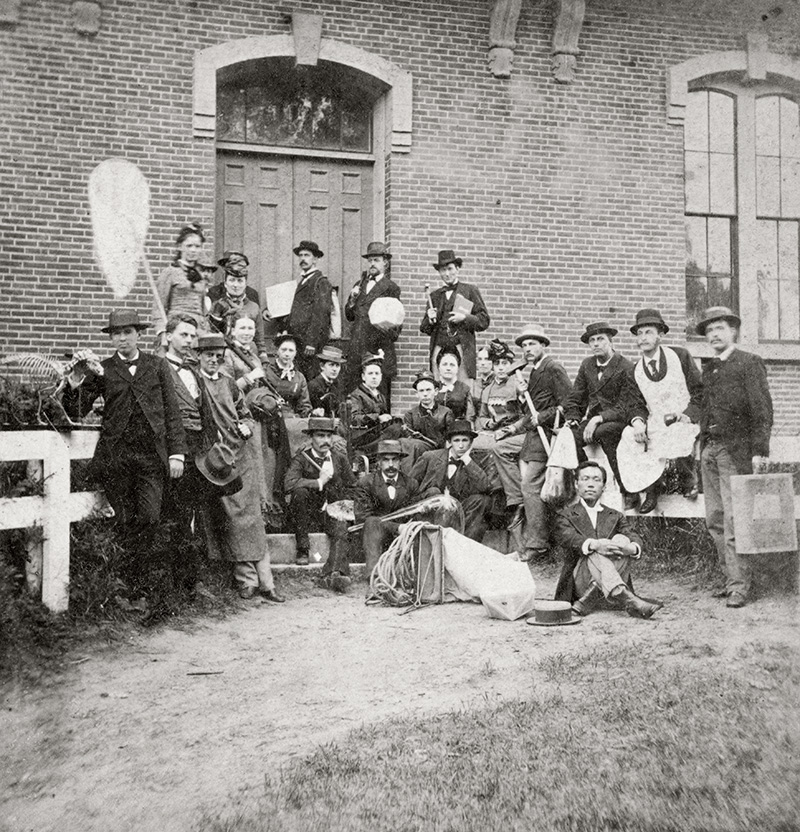
Save for those who, from Chamberlain’s time on, were permitted to audit classes, and despite Chamberlain’s inaugural rhetoric, women enjoyed few forays into Bowdoin’s educational spheres for the century that would follow. It wasn’t that coeducation was an uncharted phenomenon at the time: Bates College opened to women at its founding in the 1850s, and Cornell University admitted its first female students around the time of Chamberlain’s speech in the 1870s. And at Bowdoin, women had, in fact, woven themselves into the fabric of the College for the preceding century: wealthy benefactors, like Sarah Bowdoin and Harriet and Sophia Walker, had shaped the campus from afar, while community members like Harriet Beecher Stowe and Sarah Orne Jewett forged a vibrant literary community.
Five years after Chamberlain’s address, eleven women climbed the stairs to the Cleaveland Cabinet on the top floor of Mass Hall to fill their notebooks with the latest teachings in mineralogy, chemistry, and zoology. They were students at the Summer School of Science, Bowdoin’s program to give young, local Mainers some practice dissecting animals and handling chemicals. Comprising a little less than half of the institute’s enrollees, the women took trips to nearby quarries and coastlines to collect samples for their experiments back on campus.
Around this time, leading up to the turn of the twentieth century, women’s colleges like Bryn Mawr, Smith, and Wellesley joined earlier institutions like Vassar and Mt. Holyoke to create something of a hub of colleges for women in the Northeast. At Bowdoin, the isolation of the Maine coast encouraged a “cloister spirit,” as Chamberlain called it, a place where boys could drop and reemerge, after four years, as learned men. As women’s colleges multiplied, so too did educated women, some of whom married Bowdoin men and found themselves making a home in Brunswick. In this secluded environment, they gathered as wives of Bowdoin professors and presidents. Such was the case for the woman who would set the tone for women on campus for much of the 1900s: Edith Sills.
A graduate of Wellesley and the wife of Bowdoin president Kenneth C. M. Sills (Class of 1901), Edith Sills was, to most who knew her, the heart of Bowdoin hospitality. She made Bowdoin a familiar and warm place for students, remembering the names of each of the 400 undergraduates and usually something about their origins or proclivities—details learned through many evenings spent with various groups at the Sills home at 85 Federal Street. But Edith Sills was more than a winning host. An advocate for women’s education and a cultured traveler, Sills crafted an enduring legacy in the decades leading up to coeducation. If Bowdoin is a place where identity is shaped by those who came before, Sills clearly figures prominently.
Throughout her thirty-four years as Bowdoin’s “first lady,” Sills did what she could to bridge the gap between women and education. A teacher of Greek at Brunswick High School and a fervent classicist, Sills devoted herself to a type of learning that centered women. She was a trustee of several women’s colleges and, for a time, the president of the College Club of Portland, founded by early women college graduates in 1900 for intellectual stimulation and to encourage other women to earn bachelor’s degrees. At Bowdoin, she established a fund to bring distinguished women to speak—Eleanor Roosevelt being one warmly received guest—and endeared herself to most who met her: the student body, faculty wives, and visiting luminaries.
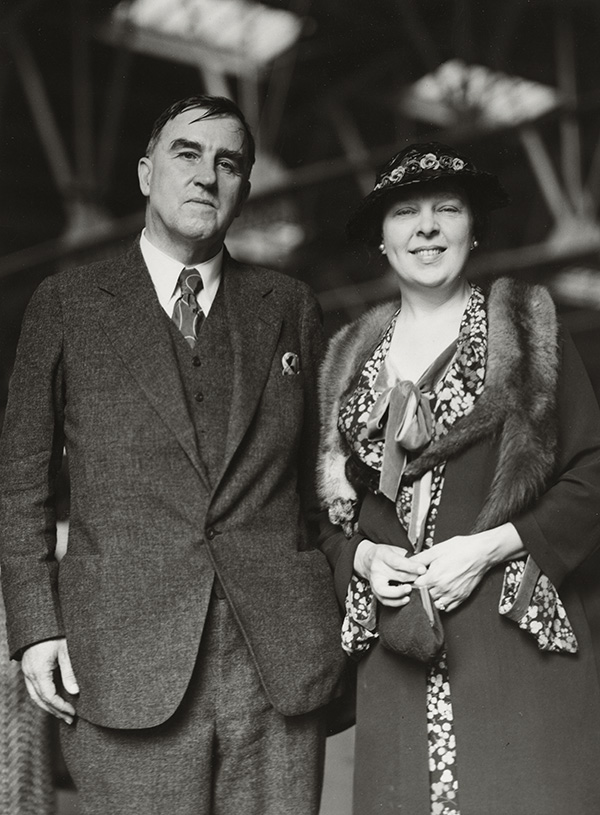
There is no mention in the archives of Sills’s direct support of coeducation. That might be because, when she arrived at Bowdoin in 1918, the dominant culture war of the time was for women’s right to vote. Sills herself was a vocal opponent of suffrage. “Our government is not a democracy but a representative republic, with the family as the unit,” she wrote. “The Suffragists are trying to tear away the cornerstone of our government by destroying the family as the unit—by allowing everybody to vote.” Sills’s opposition to suffrage points to a general truth about the history of Bowdoin women. Despite the impulse to combine suffrage and education as kindred mileposts on the long road toward women’s rights, the lines weren’t necessarily contiguous. Among women of New England, support for a coed academy didn’t necessarily translate to rights in the voting booth. “My suffrage friends are always trying to persuade me that Suffrage will broaden women’s interests and educate them,” Sills wrote elsewhere. “The object of Suffrage is to govern not to educate.”
Sills would, alongside her friend Kate Douglas Wiggin—who, in 1904, became the second woman to receive an honorary degree from Bowdoin—help found Bowdoin’s preeminent women’s organization, the Society of Bowdoin Women. The first of its kind at the College, the group coalesced to raise money for the endowment and establish a welcoming, warm space for women on campus. Requirements for participation were simple: members were to pay an annual fee of one dollar and had to “love” a Bowdoin man, whether he be a grandson, son, brother, husband, or friend. The Society’s criteria resonated; by the early 1960s, the group had more than 1,000 enrolled women, many of whom gathered at the group’s temporary headquarters in Gibson Hall during Commencement exercises.
The Society of Bowdoin Women was also in the business of funding lectures by women they deemed “outstanding.” In 1963, the Society brought Hannah Arendt, a German-born political scientist and writer, to speak on the topic of personal responsibility under dictatorship. This too was part of Sills’s legacy: as Bowdoin’s host to Eleanor Roosevelt, W. B. Yeats, Rudyard Kipling, Mark Twain, and others, Sills had introduced worldly figures to the somewhat secluded college—to its students and its community of women. Arendt, and many after her, were brought through the endowment of the Edith Lansing Koon Sills Lecture Fund.
“We kept all the women happy,” said Mary Lou Sprague, who served as president of the Society after witnessing her mother do the same. Ever since she was a girl running across the Quad in white ankle socks and Mary Janes on visits with her family, Sprague considered Bowdoin a type of home: her grandfather, father, brother, husband, and then, much later, her grandchildren, were all alumni. She was of a generation that, by the 1950s, had begun to signal the sea change that, in some ways, precipitated coeducation: an influx of student wives on campus when men who had postponed their studies for World War II enrolled at the College. The Society of Bowdoin Women gave those wives a welcoming place to go.
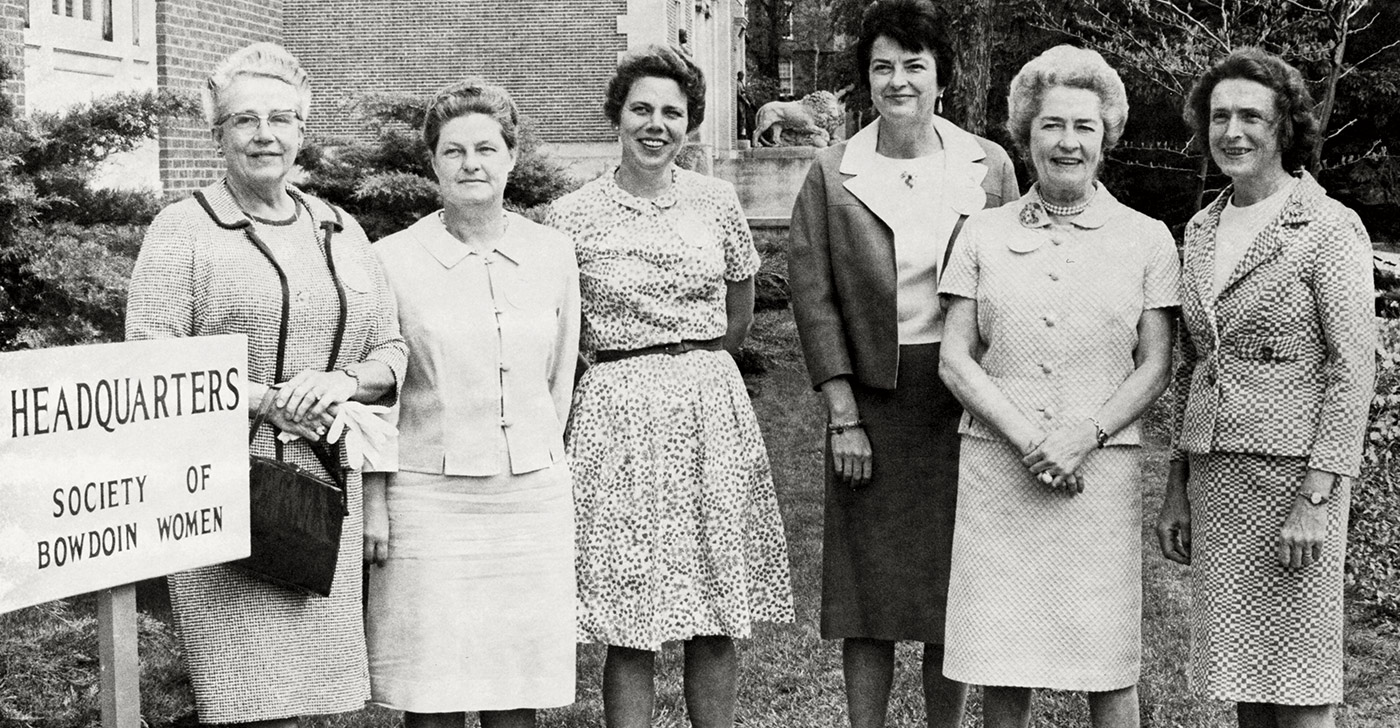
While the Society brought more women to campus, its members weren’t intimately concerned with gaining a foothold in Bowdoin’s classrooms. “I don’t think that was the kind of thing that the Bowdoin women would have made a big splash about—that would not have happened,” Sprague said in 2011. “It wasn’t something that I was particularly concerned about, and I don’t think most of my peers were. I went to a girls’ school in Portland, and then I went to Bryn Mawr, and I never felt like I had a lesser education.”
In fact, Sprague had a kind of Bowdoin education: during World War II, while she was studying at Waynflete School in Portland, underutilized Bowdoin professors—tasked with teaching a student body that had shrunk to half its usual size of 600—rode the train to teach at Waynflete. Sprague remembered these lessons fondly, though she didn’t consider them representative of the type of coeducation that was discussed at the time. Like Sills, Sprague was the type of person Helen Cafferty would encounter decades later: well-educated, welcoming, an ardent supporter of the College. For Sprague, as for Sills, believing in educating women and believing that Bowdoin should admit women were not equivalent causes, and support of one did not necessitate the other.
As World War II produced a society-wide shift in traditional gender roles, Bowdoin found itself asking women to fill positions formerly held only by men. With some professors drafted into military service, a few wives of faculty taught meteorology and mathematics in their place. When the husbands returned, along with half of the student body that had been sent abroad, these women departed the classroom. Some of them likely joined the second women’s organization at the College, the Bowdoin Wives Association. Housed in Moulton Union, the group had begun in the 1940s and provided a place for wives to mingle on campus. They hosted dances, bingo nights, fundraisers, and games of charades, which they advertised in their regular newsletter, dubbed the Chit-Chat. It also featured recipes and ads for babysitting services and house cleaners. “However unfamiliar and unexpected our presence on the Campus may have been in the tradition of the College, we ARE and will always be a REAL part of Bowdoin College, sharing its triumphs and growth with our husbands and sons,” read a 1948 newsletter.
The Bowdoin wives persisted alongside the Society women for the ensuing decades, at luncheons, dances, Commencements, and Masque and Gown productions on the museum steps. By the late ’60s, Bowdoin was still a distinctly men’s college, though the arrival of women as students loomed on the horizon. In 1968, in Wheaton, Massachusetts, a woman named Evelyn Banning wrote a letter to Richard Moll, Bowdoin’s dean of admissions. As the associate dean at Wheaton, Banning was fielding questions from Wheaton’s then all-female student body about a new exchange program, one that included Bowdoin. They were eager to know: Might the women attend Bowdoin the next fall?
For Sprague, as for Sills, believing in educating women and believing that Bowdoin should admit women were not equivalent causes, and support of one did not necessitate the other.
The next year, the College commenced a test run of coeducation. Called the Twelve College Exchange, students from colleges including Smith, Mount Holyoke, and Vassar could apply to spend a semester or a full academic year at any of the colleges in the exchange. In Brunswick, the newly arrived female students made a home in a former dean’s house on Federal Street. “Everyone is treating us like princesses—especially the students,” Tricia Luther, an exchange student from Mount Holyoke, told an Orient reporter in 1969. Luther joined the otherwise all-male cheerleading squad and seemed to have a largely positive experience during her exchange. Due to their novelty on campus, other women described feeling a bit lonely.
“Did you have a nice vacation?” begins a column in the Orient the following spring. “A question sincerely meant, a friendly smile, genuinely pleased to see you back. Haven’t seen or heard that in quite a while.” These are the first words of an open letter written by five of Bowdoin’s exchange students. “Sure, Bowdoin College was eager (perhaps still is) to have coeds, but then why do our male counterparts treat us as if we don’t exist?”
Despite these challenges, one of that letter’s authors, Susan Jacobson, decided to extend her time at the College. Just one day after the Governing Boards voted in favor of coeducation, she applied for admission as a full-time student. In 1971, she became the first woman to earn a bachelor’s degree from the College, the only one in that year’s graduating class. From the top of the Walker Art Building steps, she peered above her black-rimmed glasses, surveying her classmates and their families, and began to speak. Instead of invoking the novelty of her historic accomplishment, she credited the long legacy of Bowdoin women who preceded her.
“Loyal females have sat through subzero temperatures at football games,” she said. “[They] sewed costumes for Masque and Gown, instilled morale through the auspices of the Society of Bowdoin Women, and bequeathed monetary benefits,” she said to the crowd. “Bowdoin can now remember these selfless women by providing their descendants with a chance to earn a diploma.” Jacobson’s words conjured for the crowd a far-reaching and varied ensemble of women—past, present, and future. What mattered then, in that moment, was not whether that ensemble—of Mary Lou Sprague and the rest of the Society women—envisioned a line from their lives to the future paths of Susan Jacobson. Their continued presence, built over decades, was the through line between Bowdoin as a men’s college and Bowdoin as a place for women too. A place, continued Jacobson, that “will one day represent a harmonious microcosm in which male and female members work in complementary fashion to achieve overall unity and productivity.”
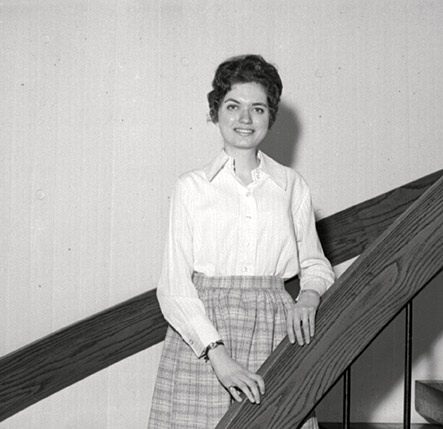
Susan Jacobson ’71 pictured in the then-Senior Center (now the entrance to Thorne Dining Hall) in April 1971. When she was five, she told her father, Payson Jacobson ’40, that she would graduate from his alma mater. “There is a slight problem,” Payson remembered saying to his daughter.
The offerings of early Bowdoin women—in the societies, the associations, the exchange programs—came to reveal and, in some ways, crystallize the forces of change that had been fomenting at Bowdoin for the preceding decades. As attendees and organizers of events, as writers and as distinguished speakers, each was a player in the long history of women at Bowdoin. Each had their own ideas about the role and influence of women, whether in the classroom or the voting booth, whether they felt those opinions to be personal, political, or even relevant to their carving out space in the College. That those might not map perfectly onto contemporary ideas of feminism speaks to the delicate complexity of what it means to be a woman forging a place for herself.
These women and their organizations built the place where Helen Cafferty arrived in 1972, when the College had welcomed women as students but still had very few on the faculty. “This was a time that, if I had been married, I would have had to have my husband’s signature to open an individual bank account with my own money,” Cafferty said. In that first year, the image of her footprints from her walk across campus still lingered in her memory, but what they signified began to change for her. Once a symbol of her personal journey, to Cafferty they became an emblem of women at Bowdoin as a whole. “I thought of them as a metaphor for the battle that was waged to achieve equal representation of women in the student body, the faculty, and administration,” she said.
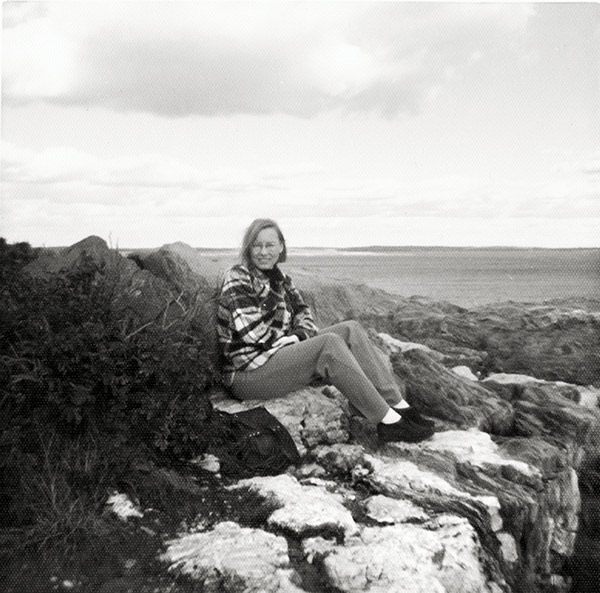
Helen Cafferty photographed at Giant’s Stairs in Harpswell in 1972, the year she began teaching at Bowdoin. One of three female professors hired by the College that year, Cafferty was the first woman to pass through all the ranks from assistant to associate to full professor. She retired from Bowdoin in 2011 and was elected William R. Kenan Jr. Professor of German and the Humanities Emerita.
In the thick of that struggle, Cafferty still felt “very lucky” and appreciated her male and female colleagues’, as well as the Society of Bowdoin Women’s, cultivation of a hospitable, welcoming environment for the new female faculty. In those years, they still held whitegloved teas and potlucks, which Cafferty attended and sometimes planned. “I am still grateful for the Bowdoin wives’ support and welcome,” she said. Without being formally admitted to the College, these Bowdoin women created a sincere, warmhearted space that ushered in Bowdoin’s first long-term female professors and graduates.
When women did arrive as students, they added their names to the accumulated memory of all those women who had shaped Bowdoin from outside of the academy for the preceding century. In the years to come, more women would join Cafferty on the faculty, including Matilda White Riley P’58, H’72, Bowdoin’s first female full professor, and Barbara Kaster, one of the first female professors to be granted tenure at Bowdoin. Roz Bernstein H’97, P’77 would soon become one of the first two female overseers of the College (and eventually the first female trustee), and Deborah Mann ’75 would speak at Commencement, representing the first fully coed class to graduate from Bowdoin. In 1971, the field hockey team became the first women’s athletic team on campus and was coached by the College’s first female coach, Sally LaPointe. A little over thirty years later, in 2007, the field hockey team would win the first national championship by any team in Bowdoin history.
Cafferty said that she views coeducation not as the time at which Bowdoin admitted women, but as the point at which women comprised 50 percent of the student body, and then, also, the point at which women reached parity in the faculty. Student body gender parity first occurred in 1992 (with the Class of 1996), and gender parity on Bowdoin’s faculty was first achieved in 2009. The women who came before coeducation unspooled a long thread. The decision to admit women as students in 1971 changed Bowdoin forever.
It would take a great deal of work by many dedicated people over many more years to tie it all together and, as Cafferty notes, to realize true coeducation.
Surya Milner ’19 is a freelance writer living in Los Angeles.
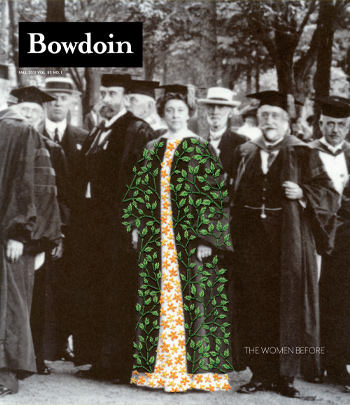
This story first appeared in the Fall 2021 issue of Bowdoin Magazine. Manage your subscription and see other stories from the magazine on the Bowdoin Magazine website.